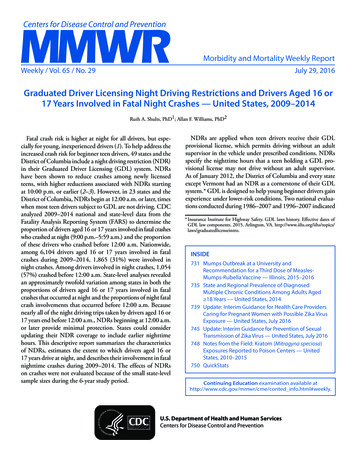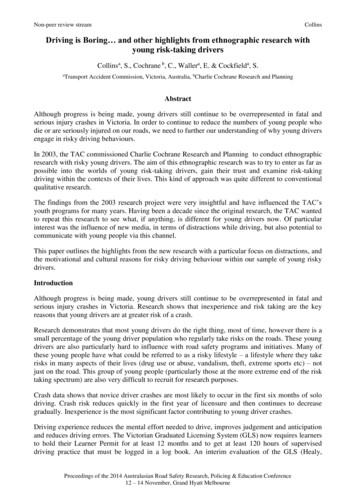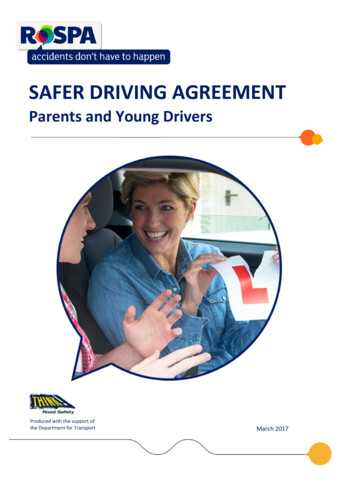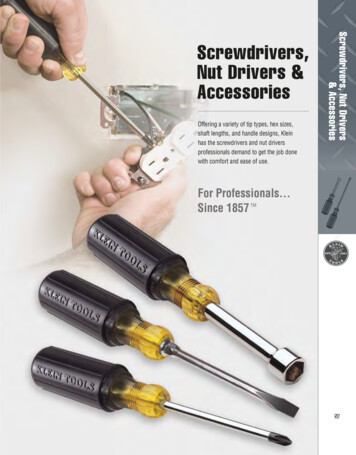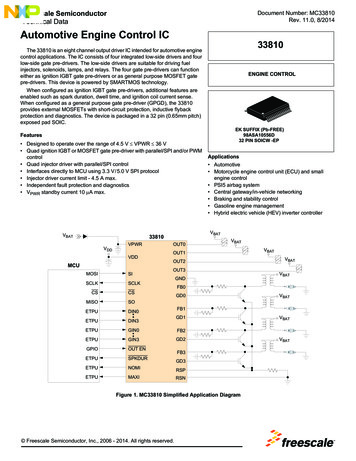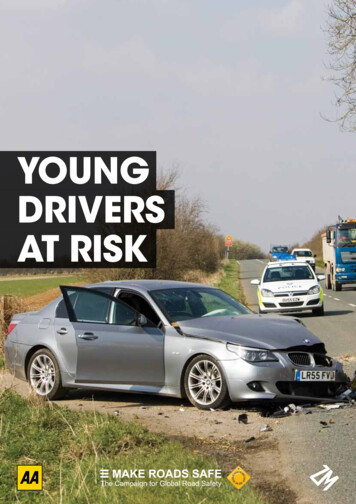
Transcription
YOUNGdriversat risk
forewordI became a world champion by driving fast. I love cars and racing.But I know the place for speed is on a race track, not on the road.Excessive or inappropriate speed is a contributory factor in manyroad crashes, and it is simple physics: the faster you are travelling,the more serious the impact is likely to be.The report we publish today finds that nearly 40% of young Britishdrivers have been involved in a road crash by the time they are 23.Those first few years of driving are a dangerous time when a lack ofexperience combined with a misplaced confidence can often resultin a crash. Fortunately many young drivers only suffer hurt pride. Butsome do not survive their first years of driving, or have to live therest of their lives with injuries or disabilities. Nearly one in three ofthose killed or seriously injured on UK roads is under the age of 25.This report on young drivers by the AA and the Make Roads Safecampaign highlights the reasons these crashes occur, and the stepsthat can be taken to avoid them. Safe mobility should be a right forall, but that means we must all play our part in making the roads safefor others, not only at home in the UK but around the world.Road crashes are now the leading cause of death worldwide foryoung people aged 10-24. Many of those killed and injured are pedestrians or cyclists. But motorcycles and cars are increasingly available to younger road users in the fast developing world. And a silentepidemic of traffic collisions is killing a thousand young people every day. Most of these deaths and injuries are unreported, or quicklyforgotten except by the families involved. But two years ago onedeath of a young teenager did catch the world’s attention. ZenaniMandela, the great-granddaughter of Nelson Mandela, was killed ina car crash on the eve of the 2010 World Cup. Now the MandelaFamily is working with the Make Roads Safe campaign to highlightthe need for better road safety for children and young people.This report is part of the Zenani Mandela Campaign, and our combined efforts to protect young lives and allow everyone to enjoydriving, walking and cycling on our roads in safety.Nigel Mansell CBEMember, Commission for Global Road Safety1Young drivers at riskYoung drivers at risk2
1. Road Injury in the UKIntroductionResearch for this report clearly showsthat new drivers are most at risk on theroads in the first year or so after passing their test.As soon as the L plates come off, somenew drivers choose to forget what theyhave learnt in order to pass their test.We have found that newly qualifieddrivers often need more training onspeed control, risks on rural roads ordriving at night.The AA Charitable Trust for Road Safety and the Environment can help new and young drivers be saferby providing further training for them once they have passed theirtest. To coincide with the publication of this report the AA Charitable Trust has pledged to fund 1,000 FREE AA Driving School’sDrive Smart courses for ‘at risk’ drivers. These are drivers who havepassed their test within the last 12 months and who may alreadyhave points on their licence or been involved in an accident. Thecourse teaches drivers safer techniques as well as tips on how todrive in a more eco-friendly or economical manner.We are grateful to the FIA and its ‘Action for Road Safety’ initiativefor a road safety grant (provided by the FIA Foundation) which willpartially fund these free courses.To apply for a free 2 x 1 hour course please go to www.theaa.com/drive-smart complete the on-line booking and enter “Mansell” under the reference. We can also offer free Drive Confident courses fornew drivers who may be nervous or anxious about aspects of theirdriving.Road deaths and injuries in the UK highlight the work that stillneeds to be done to make our roads safer for everyone who usesthem. Every day 5 people die on Britain’s roads and 67 people suffer a serious injury. Every one of those deaths and injuries causespain and heartache for far more than the one person hurt or killed:road crashes affect all those involved from passengers, witnesses,friends, families and the emergency services who come to their aid.It is a sad fact that young people are disproportionately representedin road crash statistics as is evident from the following: In 2010 nearly 1 in 3 car occupants killed or seriously injuredwere under the age of 2555 children under 16 died on the road in 2010.30 per cent of young (17-24) drivers killed were over the legaldrink drive limit, the second highest age group behind the 2530s. Nearly 25 per cent of young drivers killed were over twicethe legal limit – the highest age group for that figure.4.8 per cent of 20-24 year old men involved in crashes fail abreath test administered after an accident – the highest group.Women in this age group fail in 1.6 per cent of cases, again thehighest group.3 per cent of men aged 17-to-19 fail breath tests after crashes,less often than those aged between 20 and 24.The AA estimates that some 200 road deaths may be due todrug driving or a combination of drugs and alcohol.Driver distraction from mobile phones is a growing problem.Surveys show that one quarter of young drivers admit to accessing email or social-networking sites from their phones whiledriving26 per cent of car user deaths and 12 per cent of all road deathsare young people between 17 and 24 travelling in carsThis report also promotes more opportunities for children and youngpeople to be involved in road safety and driving from a younger age;so that when they can start learning to drive they already have asolid foundation in responsible driver behaviour.It is a sobering thought that the biggest threat of accidental deathfor our teenagers is a road crash. We must all work together to stopthese young lives being wasted.Edmund KingPresident of the Automobile Association3Young drivers at riskYoung drivers at risk4
2. What Drivers SayYoung drivers are key to improving their own safety on the road soit is vital we listen to their opinions. It is very telling that when weasked members of our AA/Populus panel what they thought abouttheir peers’ driving young drivers were the most disparaging. The AAPopulus poll of 19,284 drivers took place between 22-30 May 2012.Many young drivers (29 per cent) said they have friends whose driving is so unsafe they either refuse or avoid being driven by them. Inone sense, it is encouraging that young people are willing to avoidbeing in a car with someone they believe to be unsafe, thus reducingtheir chance of being involved in a crash. Conversely, it is concerningthat so many young drivers think some of their friends are such baddrivers they cannot safely be driven by them.Motorists on the AA/Populus panel who have had a crash have alsoshared with us the circumstances surrounding the first accident theyhad when they were driving: 37 per cent of drivers had had a crash by the time they are 23years old28 per cent had had a crash by the time they were 21 years of ageNearly one in four (26 per cent) had crashed within two years ofpassing their test23 per cent of 18 -24 year olds had been involved in a crash whilstdriving within 6 months of passing their testFirst crashes are most likely to happen in the day time, with only13 per cent happening at nightMost people have their first crash without any other passengersin the car (63 per cent)Bad weather was a factor in 15 per cent of drivers’ first crashes47 per cent had their first crash on a single carriageway or in arural areaOne third of 18-24 year olds have been involved in an crash whendriving5 per cent of drivers had their first crash on a motorbike.Drink driving is a serious area of concern for young drivers. It is notjust an issue for them in terms of being a driver, but also as a passenger. AA/Populus research shows 18-to-24 year olds are more thantwice (16 per cent) as likely to have travelled in a car with a drunk driver than any other age group (next highest was 25-35 at 7 per cent).Peer pressure also adds to the issues with almost a third (28 per cent)of 18-24 year olds saying their friends are likely to encourage them todrink ‘one more for the road’ when they are a designated driver.Many young drivers are not aware of the potential risks driving posesto them. 37 per cent of 18-24 year olds think gun and knife crime isthe greatest threat to them, compared to just 12 per cent who thinkthe greatest threat is driving. The reality is that in 2007 138 teenagedrivers were killed on the roads compared to 42 teenagers killed inknife crime incidents in 2008.5Young drivers at riskYoung drivers at risk6
3. Protecting Young DriversLearning about driving without drivingLearning about road safety starts long before someone eventhinks of getting a driving licence. A child using a child restraint orcar seat when small shows that being on the road is something thatneeds care and extra effort.Going out with parents shows that there are codes and rules to beobeyed and that responsibility is needed. This may be on the pavement, stopping at the kerb, waiting for the green man. It may alsobe in the car where having Dad or Mum shouting at cars that are intheir way or conspicuously breaking speed limits or other laws doesnot set a good example for the future.At this time, help is at hand. The Children’s Traffic Club helps parents and carers teach their children how to keep safe when out andabout, in a fun and memorable way. There are two million club members, most funded by their local authority with thousands more using materials in playgroups and nurseries.The Club works by building unique partnerships with parents, carersand road safety, health and education professionals. This approachmeans the material reaches children directly in their homes, and itsvital road safety messages are reinforced by use in other educational and child care establishments.It is a structured intervention scheme that has been proven to influence the long term behaviour of children involved. This approachworks at an early age and is recommended in Government strategy.7Young drivers at riskYoung drivers at risk8
3. PROTECTING YOUNG DRIVERSSchooldaysUnder-17 driving opportunitiesOnce at school schemes are needed that prepare children to be safepedestrians and cyclists. Primary school kids are eager to learn andat this age the value of on-road pedestrian and cycle training canbe clearly seen.AA research shows 73 per cent of drivers think young drivers wouldbe safer if they had more opportunities to have driving lessons inspecially selected off-road situations (e.g. closed off playgroundsand car parks) before they were 17 years old. Although this figurewas higher among older drivers (82 per cent of over-65’s) it was stillhigh (63 per cent) among young drivers (those aged 18-to-24).Cycle proficiency or “Bikeability” courses are essential in many ways.The courses open children’s eyes to a different method of travel. Itgives them the skills necessary to cycle and gives a good understanding of many issues they will face as drivers. There is a threephase approach – first stage away from the road, second stage onthe road and the third stage taking youngsters up to a level wherethey will be able to safely carry out cycling on any roads, and to andfrom school.This sort of training carries out another key role. It gives participants the correct attitude as well the correct skills for safe road use.Particularly when they move on to driving, attitude becomes moreand more important. Using the road should be about getting fromA to B, not about self expression or showing off.As children become teenagers they begin to think about driving andmay already be influenced in their attitudes to driving by interactive games or television and films. By early teens many – especiallymales – think they will be good drivers and that they will be able toimpress their friends with their driving.As 17 draws closer, the possibility of learning about driving in carscomes to the fore. Some consider motorcycling or the use of a motor scooter or moped which may be faster than a cycle but cheaperthan a car.Two wheels and an engineSome will stay on two wheels and opt for a motorcycle or moped– perhaps to allow them to get around where they live cheaply andefficiently. They will have to follow a legally defined course of compulsory training and test. But whenever motorcycling starts, motorcyclists will have to keep an eye on their attitudes and make surethey have the best skills.When on two wheels it is also vital that the best possible protectiveequipment is used. This can make a huge difference to the injuriessustained in even the most minor collision.Providing early driver training would create an opportunity withina controlled environment to teach young people in a practical wayabout the dangers and risks associated with driving. We advocatecombining practical lessons with classroom-style road safety lessons to try and instil a responsible attitude towards driving in youngpeople, rather than just giving them the chance to drive a car beforethey were 17 years of age.Time for the driving instructorAt 17 teenagers can drive on the road. It tends to be a rite of passage. Some learn to drive at 17 but then may spend three years awayat university not driving as they can’t afford or don’t need a car.Learning to drive must be built on a sound theoretical and attitudinal basis. But it also needs expert instruction in the early days,and only an Approved Driving Instructor can provide this. But asa learner gets more experience parents can help. They can supervise. They can give experience. An instructor may not be able totake a pupil out on windy, rainy days in the summer. A parent oftencan help give experience of all weather conditions. Experience isgained. There is much work that suggests that around 100 hours instruction and practice are needed to become a decent driver – parents can give much help in getting their learners to this level. Theycan also take them out on all sorts of roads in different conditions.Further young driver educationWhether or not a new driver chooses to drive in the manner they wererequired to pass their test is, of course, ultimately their own choice. Butdriving schools can help new and young drivers be safer by providing further training and educational opportunities for them once theyhave passed their test. The AA Charitable Trust has pledged to fund1,000 of the AA Driving School’s Drive Smart course for ‘at risk’ drivers.These are drivers who have passed their test within the last 12 monthsand who may already have points on their licence or been involved inan accident. The course teaches drivers safer techniques as well as tipson how to drive in a more eco-friendly or economical manner.Clearly when it comes to drink driving education there is morethat could be done to improve young people’s attitudes. The AACharitable Trust would like to see more opportunities for childrenand young people to be involved in road safety and driving froma younger age; so that when they can start learning to drive thealready have a solid foundation in responsible driver behaviour.9Young drivers at riskYoung drivers at risk10
3. PROTECTING YOUNG DRIVERSA legislative framework for young driversEyes in carsIn the UK teenagers can drive legally at 17. Many countries allowdriving at 15 or 16 and impose restrictions on these drivers (like notallowing driving late at night, or with friends). There are debatesabout imposing similar restrictions here. Some of the countries witha driving age of 18 introduce incentives to let youngsters get practice earlier. Again there could be opportunities here.Not all young drivers are bad drivers but insurance premiums reflectthe higher general risk posed by young drivers. By using more sophisticated “black box” technology the driving styles and risks drivers take can be tracked and premiums adjusted accordingly.It cannot be doubted that restricting young drivers would cut thenumber of crashes. Much evidence shows that young drivers don’tdrive badly because they don’t know how to drive well. They drivebadly because they think this is how their friends expect them todrive. Keeping them from driving their friends (or from driving atnight when the worst incidents happen) could reduce these crashes.In the UK there are restrictions on new drivers. Drivers in their firsttwo years of gaining a licence, lose their licence if they acquire 6penalty points rather than 12 points for more experienced drivers.This measure is designed to get the worst drivers out of the systemquickly, and also aims to reduce the “friend effect”. Young peopleshould know that encouraging the driver to take risks may cost thedriver their licence.Over restrictive legislation regarding new drivers may have someunintended consequences. Many new drivers also work, perhapspart-time or at night, and need a car to get to work.Cops in carsEnforcement or threat of being caught is essential in road safety.All previous effective safety campaigns were followed up with visible enforcement. Effective drink drive legislation coincided with theintroduction of the breathalyser.The number of traffic police enforcing the law on UK roads has beencut by nearly 12 per cent over the past five years, according to datafrom Freedom of Information requests to 52 UK police forces.For example, the AA has introduced Drivesafe which is an insuranceproduct where the premiums are based on how the driver drivesby measuring speeds, acceleration and braking. Such technologyshould ultimately bring down insurance costs for responsible newdrivers but can also have wider safety benefits. The tracking systemshould encourage drivers to stick to speed limits and improve driverbehaviour.Safer roads, safer cars, mean safer driversImproving driver training and behaviour can make roads safer. Safercars also have a huge role to play. Improved crash protection, instigated by the Euro NCAP crash test programme, already meansthat drivers can avoid death in crashes that in the past would haveresulted in deaths.Technology such as ABS, ESC and e-call can bring wider benefitsfrom crash avoidance to calling the emergency services automatically after an incident.Road design also has a role to play in improving safety. The EuroRAP programme shows that we can create an environment wherethe risks are reduced by erecting protective barriers, improving visibility, redesigning junctions, reducing speed limits or improvingroad surfaces.A concerted effort to introduce all these measures in a ‘Safe Systems’ approach would help reduce the death toll of young driversand indeed all road users. Efforts to improve driver training, behaviour and attitudes, coupled with better enforcement, safer roads andsafer cars, can help us push road deaths closer and closer to zero.Everyone in road safety is united in wanting more police but changing priorities in crime prevention, and lately government spendingcuts, mean there is no sign of them being forthcoming.It is questionable whether introducing new laws on young driverswould be effective if the laws are not enforced.There is also strong evidence that cops in cars are also effective atdeterring or resolving other crimes. Home Office research showsthat the most serious motoring offenders are much more likely to beinvolved in other wider crimes. Hence if serious motoring offendersare targeted it is likely that other crimes will be resolved.11Young drivers at riskYoung drivers at risk12
4. A Global CrisisRoad crashes are not only the leading cause of death and injury foryoung people in the UK, but also around the world.Teenagers and young adults starting out on their independent lives- whether they are on foot, on bicycles, or behind the wheel - aremost at risk on the roads. Safely navigating these early journeys, aschildren travelling unaccompanied to school or as novice drivers,must be a priority. Yet a thousand young people under the age of25 die on the world’s roads every single day. Many thousands moreare injured.This tragic toll of preventable road injury is set to increase unless action is taken. The World Health Organization has forecast that globalroad deaths could double over the next ten or fifteen years, andby 2015 road traffic injuries are expected to be the leading healthburden for children over the age of five in developing countries. According to UNICEF, “averting injuries in the second decade of lifemust become a major international health objective”.The United Nations Decade of Action for Road Safety 2011-2020has been launched with the goal of ‘stabilising and reducing’ globaltraffic injuries by 2020.For every lifeZenani Mandela was 13 years old when shedied in a car crash on the eve of the 2010football World Cup. Her tragic death unitedthe world in grief, and for a brief time highlighted in the media the terrible global tollof child death and injury in road crashes.Now the Mandela Family is supporting theZenani Mandela Campaign in her name, withthe objective of raising awareness around theworld of the scale of avoidable human sufferingand encouraging road injury prevention so that otherfamilies do not lose their children on the roads.Zindzi Mandela, Zenani’s grandmother, has described the globalcampaign for road safety as “a vital cause for public health, sustainable development and human rights”. Ahead of the 2nd UN GlobalRoad Safety Week, in May 2013, we are campaigning to raise theprofile of road safety and to ensure that governments, car manufacturers, road designers and the public all do more to make roads safe.Governments, companies and organisations are being encouragedto make road safety a priority by improving road design, vehiclesafety and police enforcement of inappropriate speed, drink drivingand distracted driving. And all of us can play a part in achieving thegoal of the Decade of Action by behaving safely on the road.13Young drivers at riskYoung drivers at risk14
Support theZenani MandelaCampaignYou can become involved in the globalZenani Mandela campaign. Please visitwww.makeroadssafe.org to see how youcan join the Mandela Family in urging actionto protect children and young people on theroads.Zenani Mandela, great granddaughterof Nelson Mandela, was killed in a roadcrash 2 days after her 13th birthday.Didier DrogbaNaomi CambellLewis HamiltonZindzi MandelaOther parents must not go through the pain that Iam suffering and will continue to suffer. Now is thetime for positive action. Every life we save will be aprecious victory”.Zoleka MandelaFor more information visit the MAKE ROADS SAFE website: www.makeroadssafe.org
1 Young drivers at risk Young drivers at risk 2 I became a world champion by driving fast. I love cars and racing. But I know the place for speed is on a race track, not on the road. Excessive or inappropriate speed is a contributory factor in many road crashes, and it is simple physics: the faster you are travelling,


